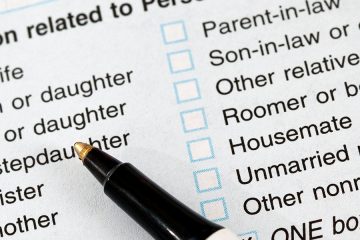When does the 2020 Census start?
While April 1, 2020 is officially Census Day, preparation for the population count starts nearly a decade in advance, and enumeration takes place over several months. The 2020 Census kicks off in January 2020 with the population count in remote parts of Alaska—while the area is frozen and traversable.3 Notices and forms will start arriving in the mail in March 2020. For households that don’t respond to the census, nonresponse follow-up begins in April 2020 and wraps up at the end of July 2020.
The Census Bureau was expected to publish apportionment population counts (used to redistribute the 435 seats in the U.S. House of Representatives) within nine months of Census Day—by December 31, 2020. Given delays related to the coronavirus, this date may change.
Can I refuse to answer a census question?
While participation in the census—and answering all questions—is mandatory, people occasionally leave a question blank. The Census Bureau uses a statistical procedure to fill in any missing responses.
Will the Census Bureau keep coming to my door if I don’t fill out my 2020 Census form?
If you don’t respond to the 2020 Census, the Census Bureau will send up to five mailings to your address and an enumerator to your door.6 For up to six days (with the possibility of more than one contact attempt per day), an enumerator will attempt to gather census information from someone in the household.7 After each contact attempt, the enumerator will leave a “Notice of Visit” form encouraging households to respond via mail, phone, or online. After three days of attempting to contact someone at the address, an enumerator may begin contacting neighbors to request a proxy response for the nonresponding household.
What is an enumerator?
An enumerator is a specially trained Census Bureau employee who collects census information from people in-person. Enumerators carry identification with their name and photograph, a Department of Commerce watermark, and an expiration date. They also carry materials such as a bag or laptop with the Census Bureau logo.
Will I have to answer the 2020 Census online?
The 2020 Census is designed to be easy, safe, and quick to complete online. However, in some places (such as remote Alaska) the count will be conducted by in-person enumerators. All households will have the option to complete and mail back a paper form, complete the questionnaire over the phone, or provide responses to an in-person enumerator.
Are census responses confidential?
The confidentiality of census records is protected by Title 13 of the U.S. Code. No data or tabulation may be produced that could be used to identify an individual. Individual records may not be released for at least 72 years.
How are census data collected?
In 2020, households will have the option of responding online, by mail, or by phone. The Census Bureau expects many households to complete the questionnaire online using instructions received in the mail. These instructions will also include information about how to respond by phone. Some households will receive a printed questionnaire, which they can mail, postage-free, back to the Census Bureau. A small percentage of households, primarily located in remote areas of the country, will be visited by a census taker who will help collect the information needed to complete the form. Every address that doesn’t respond (via internet, mail, or phone) to initial mailings will be visited by a census taker.
What information does the census collect? What questions does the census ask?
The 2020 Census form will include just a handful of questions that are asked about every person in a household:
- Name.
- Relationship to Person 1.
- Sex.
- Age.
- Date of birth.
- Hispanic origin.
- Race.
Person 1, the individual filling out the form, is also asked a few additional questions such as whether the home is owned or rented and some clarifying questions about how many people should be counted at that address:
- “How many people were living or staying in this house, apartment, or mobile home on April 1, 2020?”
- “Were there any additional people staying here on April 1, 2020 that you did not include in Question 1?”
- “Does this person usually live or stay somewhere else?”
For more information about what the Census Bureau will ask in the 2020 Census and why, see PRB’s “Why Are They Asking That? What Everyone Needs to Know About 2020 Census Questions.”
What questions aren’t on the 2020 Census?
The Census Bureau does not ask for a Social Security number, bank account information, or information about political party affiliation.8 The census form will not include any questions about a person’s religion or citizenship status.
What’s the difference between the 2020 Census and the American Community Survey?
The decennial census, conducted once every 10 years, is a complete count of the entire U.S. population. It asks just a few questions about every person and household. The American Community Survey (ACS), conducted continuously since the early 2000s, is an ongoing survey of just a portion of the population. The ACS asks dozens of questions on a wide variety of topics to gather information about the demographic, social, economic, and housing characteristics of the population.
How will the 2020 Census count everyone?
Through a process of contacting every household, group quarters facility (such as college dormitory, barracks, or prison), and homeless support facility (such as shelter or soup kitchen) the Census Bureau will attempt to count the entire U.S. population in 2020. The contact process includes a series of mailings and advertisements. Nonresponding households will be visited by a specially trained employee, known as an enumerator, who can collect census information.
The Census Bureau’s goal is to count everyone “once, only once, and in the right place.” But even with robust public outreach, advertising, and data collection processes, the 2020 Census, like previous censuses, will count some people more than once and miss others entirely. The net undercount rate—an important measure of the accuracy and completeness of the census—is calculated as the difference between the number of persons who were missed and the number who were counted more than once or included in the census erroneously, expressed as a percentage.
How does the Census Bureau know where people live?
To count every person, the Census Bureau relies on an accurate and up-to-date list of residential addresses. This list is known as the Master Address File, and includes addresses served by the U.S. Postal Service, information gathered from local governments, and information updated by Census Bureau employees in the field.
Where does the Census Bureau count people who have more than one home?
The Census Act of 1790 established—and every U.S. census has been based on—the concept of “usual residence,” which is the place where a person lives and sleeps most of the time. Identifying usual residence is straightforward for most people. But not everyone has a residential address, and some people live at more than one residence during different times of the year.
To handle these kinds of special cases, the Census Bureau has established residency rules that provide guidance to respondents who may be unsure of how (or where) to record their residence on April 1. For example:
- College students who live in college/university student housing are counted at the student housing rather than at their parents’ or guardians’ homes.
- Newborn babies who are not yet discharged from the hospital are counted at the residence where they will live and sleep most of the time.
- People who are living at a shelter (such as domestic violence and homeless shelters) are counted at the shelter.
- People in temporary group living quarters established for victims of natural disasters are counted at the residence where they live and sleep most of the time. If they don’t have a usual home elsewhere, they’re counted at the facility.
- U.S. military personnel assigned to military vessels with a U.S. homeport on Census Day are counted at the onshore residence where they live and sleep most of the time. If they have no onshore residence, they’re counted at their vessel’s homeport.
- People with seasonal homes or who have transitory living arrangements (such as RV parks, carnivals) are counted at the residence where they live and sleep most of the time. If they have no usual residence, they’re counted at their location on Census Day.
Are foreign citizens counted in the Census?
The U.S. Constitution mandates that a census be taken every 10 years to count all people—both citizens and noncitizens—living in the United States.9 Foreign citizens are considered to be living in the United States if, at the time of the census, they’re living and sleeping most of the time at a U.S. residence. The foreign resident population includes legal permanent residents, foreign students in the United States on student visas, foreign diplomats and embassy staff, and other foreign citizens who reside in the United States on Census Day. However, citizens of foreign countries visiting the United States (such as on a vacation or business trip) are not counted in the census.
Will the 2020 Census be available in languages other than English?
By eliminating the guesswork in how many translated forms to print and mail, the internet response option makes it easier to provide census materials in multiple languages. The 2020 Census Internet Self-Response Instrument and questionnaire assistance will be available in 12 non-English languages (Arabic, Chinese, French, Haitian Creole, Japanese, Korean, Polish, Portuguese, Russian, Spanish, Tagalog, and Vietnamese).10 Bilingual (English and Spanish) materials will include enumerator instruments, paper questionnaires, mailings, and field enumeration. In addition, language guides, language glossaries, and language identification cards will be available in 59 non-English languages.
When will 2020 Census results be released?
The Census Bureau was expected to publish the first results from the 2020 Census—the total population for each state—by December 31, 2020. Redistricting files, which contain data by block on the total population by race and Hispanic origin and the population ages 18 years and older by race and Hispanic origin, were planned for March 31, 2021.11 But these dates may be adjusted to reflect coronavirus-related delays.12
How can I help ensure an accurate census count in my community?
A complete and accurate count of the population is crucial to supporting the next decade of government and business decisionmaking. To help ensure a complete count, you can:
- Follow the Census Bureau on social media (Twitter, Facebook) to learn about and share important updates.
- Explain the importance of the 2020 Census to family, friends, and neighbors.
- Form or participate in a Complete Count Committee (CCC). A CCC is typically made up of government and community leaders who can organize a 2020 Census awareness campaign, based on their local area knowledge.
- Work in field operations for the 2020 Census.
- Complete and return your census form in 2020!
For more information, see the U.S. Census Bureau’s “5 Things You Can Do Now to Support an Accurate 2020 Census.”
References
1National Archives, “The Constitution of the United States: A Transcription,” www.archives.gov/founding-docs/constitution-transcript.
2Marisa Hotchkiss and Jessica Phelan, Uses of Census Bureau Data in Federal Funds Distribution (Washington, DC: U.S. Census Bureau, 2017).
3U.S. Census Bureau, “2020 Census Program Management Review” (Feb. 1, 2019) https://www2.census.gov/programs-surveys/decennial/2020/program-management/pmr-materials/02-01-2019/pmr-welcome-high-level-updates-2019-02-01.pdf?#.
4U.S. Code, Title 13, https://www.govinfo.gov/content/pkg/USCODE-2017-title13/html/USCODE-2017-title13-chap7-subchapII-sec221.htm.
5W. Gardner Selby, “Americans Must Answer U.S. Census Bureau Survey by Law, Though Agency Hasn’t Prosecuted Since 1970,” PolitiFact, Jan. 9, 2014, https://www.politifact.com/texas/statements/2014/jan/09/us-census-bureau/americans-must-answer-us-census-bureau-survey-law-.
6U.S. Census Bureau, “How the 2020 Census Will Invite Everyone to Respond” (May 9, 2019), https://www.census.gov/library/visualizations/2019/comm/2020-everyone.html.
7U.S. Census Bureau, 2020 Census Detailed Operational Plan for: 18. Nonresponse Followup Operation (NRFU), https://www2.census.gov/programs-surveys/decennial/2020/program-management/planning-docs/NRFU-detailed-operational-plan_v20.pdf.
8U.S. Census Bureau, “Frequently Asked Questions,” https://www2.census.gov/about/partners/general/2020-faqs.pdf?.
9National Archives, “The Constitution of the United States: A Transcription,” www.archives.gov/founding-docs/constitution-transcript.
10U.S. Census Bureau, 2020 Census Program Memorandum Series: 2018.06, Feb. 27, 2018, https://www2.census.gov/programs-surveys/decennial/2020/program-management/memo-series/2020-memo-2018_06.pdf.
11Raphael Corrado, 2020 Census Program Management Review, U.S. Census Bureau, April 8, 2015, https://www2.census.gov/census_2020/pmr_materials/2015-04-08/04%20PMR_2020%20Census%20Schedule_4-8-15_v1.0_Final.pdf.
12U.S. Census Bureau, “2020 Census Operational Adjustments Due to COVID-19,” https://www.census.gov/library/fact-sheets/2020/dec/2020-operational-adjustments-covid-19.html




